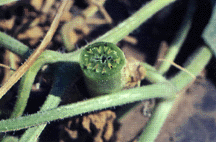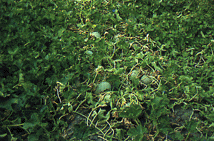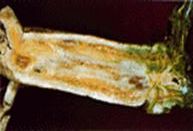Fusarium Wilt: Fusarium oxysporum f. sp. melonis attacks muskmelon and Fusarium oxysporom f. sp. niveumattacks watermelon.
Symptoms
-
Both fungi contribute to damping-off of seedlings, but most significant losses occur after young plants are infected in the field.
-
Plants infected early in the season often produce no marketable fruits.
-
Plants that begin to show wilt symptoms at or near maturity produce fewer and lower quality fruits.
-
The first symptoms of Fusarium wilt are wilting and chlorosis (yellowing) of older leaves. The wilt is most evident during the heat of the day.
-
Plants may appear to recover by morning, only to wilt again in the afternoon.
-
Stem cracks and brown streaks often appear near the crown of the plant and are associated with a red-brown exudate.
-
Fusarium wilt also causes vascular browning that is visible in stem cross-sections.
Management
-
Planting resistant cultivars is the only reliable way to keep infested fields in production.
-
Commercially acceptable resistant cultivars exist, but extremely high pathogen populations in the soil can overcome their resistance.
-
Therefore, methods to reduce Fusarium populations in the soil also should be employed.
-
These methods include extended rotations with crops other than cucurbits and fall plowing of severely infested fields.
|
|



